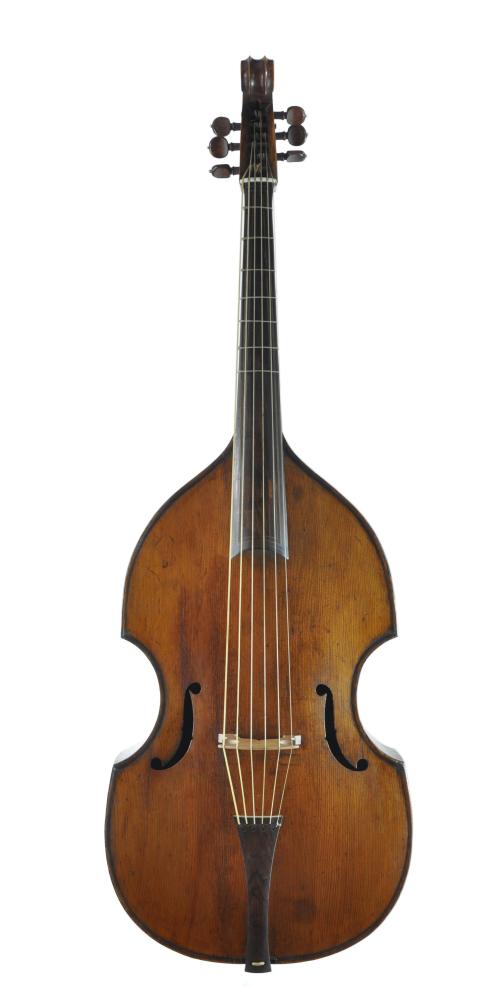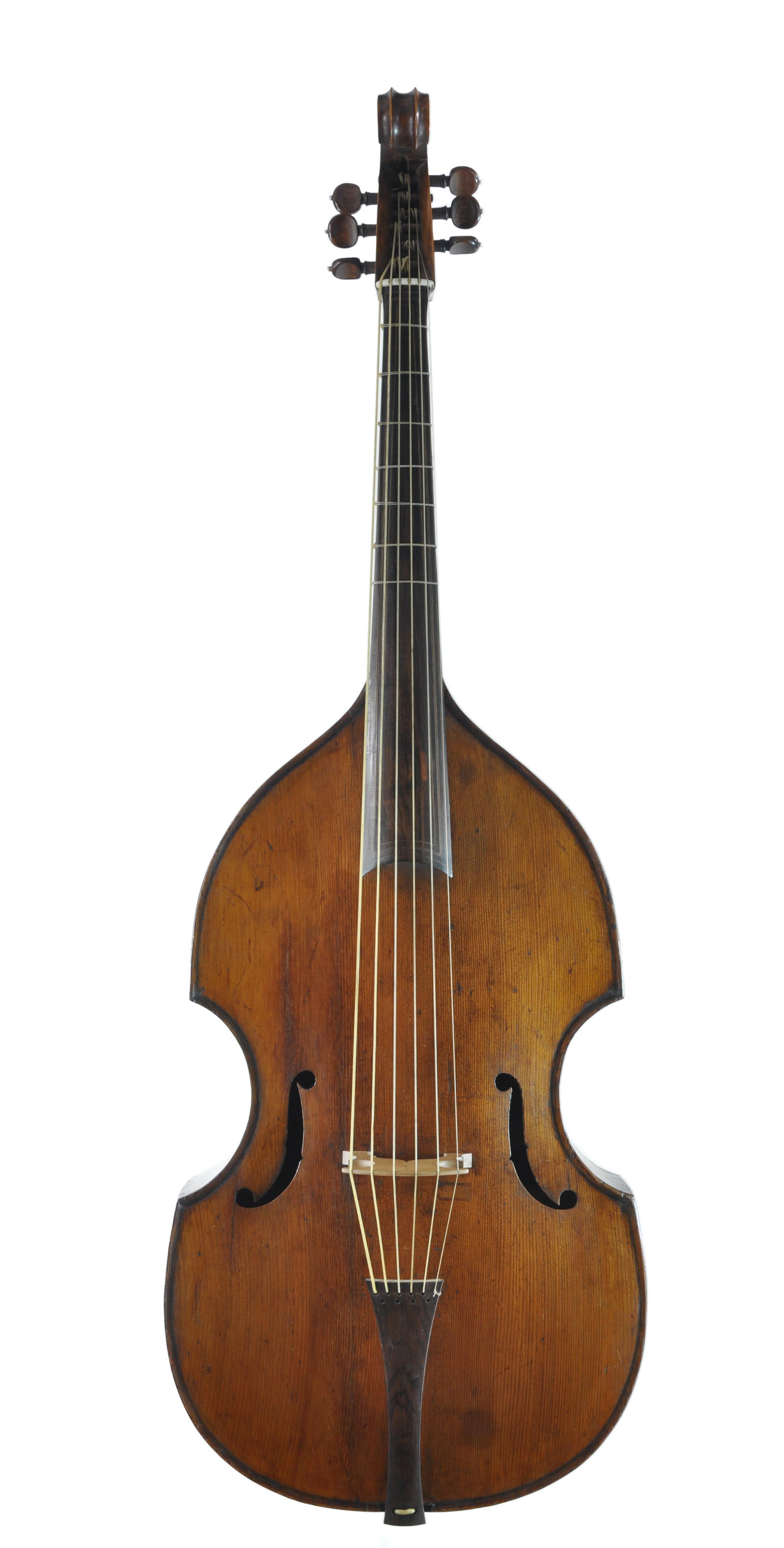Home
>
Works
>
Bass viola da gamba
>
Advanced Search
Bowed Strings
Violoncellos
Bass viola da gamba
Alternate name:Bass viol
Alternate name:Violoncello
Alternate name:Cello
Date: 1582
Place Made:Venice, Italy, Europe
Serial No: none
Signedwritten in black ink on inside of back: 1582 / Ventura in Venetia / F
DescriptionVentura Linarol was one of the first documented stringed instrument makers in Venice. A number of his finely crafted instruments survive, including a nearly identical violone preserved at the Kunsthistorisches Museum in Vienna, also made of bird's-eye maple on the back and sides. Distinctive features include the f-holes and scroll, which were of forms only used by Linarol. The fingerboard and neck of the instrument are original, but carved down for later use as a violoncello.
Top: two-piece, quarter-cut spruce: medium to wide grain, broadening toward the flanks; carved
Back: two-piece, slab-cut maple: bird's-eye figure; flat with break in upper bouts; back does not extend over heel of neck
Ribs: slab-cut maple: bird's-eye figure; bottom ribs divided by strips of rosewood and double purfling
Head and neck: maple: plain; three rows of scroll fluting; scroll ears do not protrude; scroll fluting does not continue into pegbox; double purfling inlaid on back and sides of pegbox; original neck narrowed for use as a 'cello; nail through neck at neck heel – later repair
Edging: sharply scooped close to edge; not scooped on back
Purfling: standard (dark-light-dark) and double (dark-light-dark-light-dark) strips; double purfling on top and pegbox; three strips of purfling on back, standard-double-standard
Varnish: golden-brown
Fingerboard: maple veneered in rosewood, with reverse–colored standard (light-dark-light) and double (light-dark-light-dark-light) purfling inlay along edges; wedge-shaped with scalloped profile; concave outline to lower end
Nut: bone or ivory
Tailpiece: beech, sycamore, or maple veneered in rosewood; drilled for viol or 'cello, with four holes below six; later; see photos
Pegs: modern rosewood with bone pins
Endpin: maple; later
F-holes: narrow, pointed wings; undercut
Linings: none; spruce blocks glued along joint between back and ribs; see photos
Corner blocks: spruce
Top block: spruce; four nails through top block into neck; see photo
Braces: five spruce, at upper bouts, back break, upper corners, lower corners, upper bouts; brace near lower corners has chamfered edges; see photo
Tool marks: broad-toothed plane marks visible on inside of ribs; scraper marks visible on inside of back
Technical drawing available for purchase.
Top: two-piece, quarter-cut spruce: medium to wide grain, broadening toward the flanks; carved
Back: two-piece, slab-cut maple: bird's-eye figure; flat with break in upper bouts; back does not extend over heel of neck
Ribs: slab-cut maple: bird's-eye figure; bottom ribs divided by strips of rosewood and double purfling
Head and neck: maple: plain; three rows of scroll fluting; scroll ears do not protrude; scroll fluting does not continue into pegbox; double purfling inlaid on back and sides of pegbox; original neck narrowed for use as a 'cello; nail through neck at neck heel – later repair
Edging: sharply scooped close to edge; not scooped on back
Purfling: standard (dark-light-dark) and double (dark-light-dark-light-dark) strips; double purfling on top and pegbox; three strips of purfling on back, standard-double-standard
Varnish: golden-brown
Fingerboard: maple veneered in rosewood, with reverse–colored standard (light-dark-light) and double (light-dark-light-dark-light) purfling inlay along edges; wedge-shaped with scalloped profile; concave outline to lower end
Nut: bone or ivory
Tailpiece: beech, sycamore, or maple veneered in rosewood; drilled for viol or 'cello, with four holes below six; later; see photos
Pegs: modern rosewood with bone pins
Endpin: maple; later
F-holes: narrow, pointed wings; undercut
Linings: none; spruce blocks glued along joint between back and ribs; see photos
Corner blocks: spruce
Top block: spruce; four nails through top block into neck; see photo
Braces: five spruce, at upper bouts, back break, upper corners, lower corners, upper bouts; brace near lower corners has chamfered edges; see photo
Tool marks: broad-toothed plane marks visible on inside of ribs; scraper marks visible on inside of back
Technical drawing available for purchase.
DimensionsLength of body: 61.3 cm (Pringle drawing)
Depth of ribs: 12.2 cm
Width of upper bouts: 32 cm
Width of lower bouts: 34 cm
Vibrating string length: 64.5 cm
Depth of ribs: 12.2 cm
Width of upper bouts: 32 cm
Width of lower bouts: 34 cm
Vibrating string length: 64.5 cm
ProvenanceAccording to Leandro Bisiach, Jr., with whom Witten negotiated the purchase of seven Viols in 1968-69, two of the instruments – the Linarol, Venice, 1582, and the Zanetto, Brescia, before 1564 – were among four instruments acquired by his father in the late 19th century from the Correr collections in Venice, most of which were sold in the 19th century to the Brussels and Vienna museums. Purchased by Laurence Witten from Giacomo and Leandro Bisiach, Venegono Superiore, Italy, 1968.
Purchased by the National Music Museum from Laurence Witten family, New Haven, Connecticut, 1984.
Purchased by the National Music Museum from Laurence Witten family, New Haven, Connecticut, 1984.
Terms
Credit Line: Witten-Rawlins Collection, 1984
Not on view
Published ReferencesMargaret Downie Banks, “North Italian Viols at the Shrine to Music Museum,” Journal of the Viola da Gamba Society of America, Vol. XXI 1984), pp. 14-15 with photo p. 15.
Laurence Witten, II, “Apollo, Orpheus, and David,” Journal of the American Musical Instrument Society, Vol. 1 (1975), pp. 51-52.
Laurence Witten, “The Surviving Instruments of Andrea Amati,” Early Music, Vol. 10, No. 4 (October 1982), p. 487.
AMIS Newsletter February 1985, p. 5
André P. Larson, The National Music Museum: A Pictorial Souvenir (Vermillion: National Music Museum, 1988), inside front cover.
George Monaghan, “A Rare Restoration,” Minneapolis Star Tribune, August 5, 1991.
CD Rom: the Violinmakers of Venice 1582-1885. Reuning & Son Violins 2005. DATA 019. Photograph from Boston exhibit, 2002.
Laurence Witten, II, “Apollo, Orpheus, and David,” Journal of the American Musical Instrument Society, Vol. 1 (1975), pp. 51-52.
Laurence Witten, “The Surviving Instruments of Andrea Amati,” Early Music, Vol. 10, No. 4 (October 1982), p. 487.
AMIS Newsletter February 1985, p. 5
André P. Larson, The National Music Museum: A Pictorial Souvenir (Vermillion: National Music Museum, 1988), inside front cover.
George Monaghan, “A Rare Restoration,” Minneapolis Star Tribune, August 5, 1991.
CD Rom: the Violinmakers of Venice 1582-1885. Reuning & Son Violins 2005. DATA 019. Photograph from Boston exhibit, 2002.
Object number: 03377





